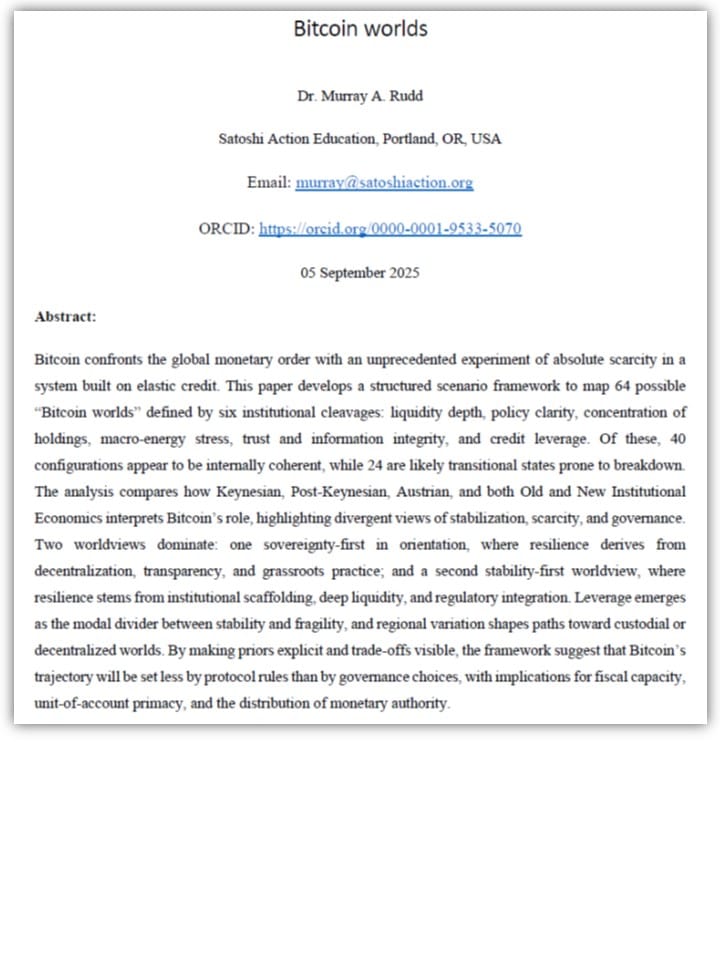Modeling Bitcoin’s Supply, Liquidity, and Policy Trajectories
The September 06, 2025 episode of the Robin Seyr Podcast features Murray Rudd outlining a supply-and-demand price modeling framework for Bitcoin that highlights how fixed supply and shifting demand interact to produce price volatility.

- My 'briefing notes' summarize the content of podcast episodes; they do not reflect my own views.
- They contain (1) a summary of podcast content, (2) potential information gaps, and (3) some speculative views on wider Bitcoin implications.
- Pay attention to broadcast dates (I often summarize older episodes)
- Some episodes I summarize may be sponsored: don't trust, verify, if the information you are looking for is to be used for decision-making.
Summary
The September 06, 2025 episode of the Robin Seyr Podcast features Murray Rudd outlining a supply-and-demand price modeling framework for Bitcoin that highlights how fixed supply and shifting demand interact to produce price volatility. Rudd emphasizes the uncertainty surrounding liquid supply, the role of withdrawal sensitivity to price, and how derivatives and synthetic exposure may “kink” effective supply. He contrasts sovereignty-first self-custody with Wall Street financialization, projecting probability-based price paths that include a modeled trajectory toward $4.8M by 2036. The full Satoshi Action working paper is available for download at: https://dx.doi.org/10.2139/ssrn.5386623
Take-Home Messages
- Liquid Supply Uncertainty: Estimates ranging from 4–13M coins create major uncertainty in volatility and supply-shock timing.
- Price-Sensitive Withdrawals: Budget limits mean fewer coins are withdrawn at higher prices, moderating—but not preventing—supply squeezes.
- Derivatives and Synthetic Exposure: Futures can defer on-chain demand but embed leverage and fragility if structures fail.
- Policy Path Dependence: U.S. and allied policy choices may lock Bitcoin into sovereignty-first or financialized market structures.
- Probability-Based Planning: Monte Carlo bands, not single forecasts, offer credible guardrails; supply shocks could emerge as early as 2030.
Overview
Murray Rudd begins by explaining that Bitcoin’s defining feature is its inelastic supply: the number of coins cannot adjust to shifts in demand. This characteristic forces price to fluctuate as demand rises or falls, making accurate measurement of liquid supply the central challenge for modeling. He argues that although total supply is transparent, the portion truly available to the market may be far smaller, with estimates spanning a 4–13 million coin range.
To address this uncertainty, Rudd employs Monte Carlo simulations, which generate probability bands rather than single forecasts. He notes that this approach produces more realistic planning tools because it captures how different assumptions about liquid supply, demand growth, and withdrawal sensitivity interact. The output suggests that there is a 75% probability of Bitcoin exceeding $2.27M by 2030, with a longer-term trajectory toward $4.8M by 2036.
One refinement in the latest version of his model accounts for withdrawal sensitivity to price. Rudd explains that as price rises, budget constraints reduce the number of coins that buyers can remove from liquid supply. This adjustment dampens the speed at which supply shocks could occur, but it does not eliminate the possibility of hyperbolic price surges under certain conditions.
Derivatives and synthetic exposure add further complexity. Futures markets can satisfy demand without requiring the movement of actual coins, which in practice “kinks” the supply curve around current price levels. Rudd cautions, however, that while such structures may reduce volatility in the short run, their failure could cause abrupt shifts as deferred demand floods back onto the chain.
Looking forward, Rudd contrasts two broad scenarios. A sovereignty-first pathway, anchored in self-custody and resistance to paper Bitcoin, could tighten liquid supply and amplify long-term volatility. By contrast, a stability-first trajectory defined by Wall Street integration may compress volatility but embed leverage and counterparty risks. He stresses that early U.S. policy decisions will strongly shape which equilibrium dominates over the coming decade.
Stakeholder Perspectives
- Long-term holders: Favor sovereignty-first practices that steadily reduce liquid supply and reinforce scarcity.
- Institutional investors: Prefer regulated entry through ETFs and derivatives that provide exposure without slippage.
- Exchanges and brokers: Gain from higher trading volumes in synthetic markets but carry risks from leverage and counterparty exposure.
- Regulators and central banks: Focus on systemic risk management, especially where derivatives and high volatility intersect with broader markets.
- Miners and energy partners: Depend on price trajectories and volatility regimes to guide investment and treasury strategies.
- Corporate treasurers: Evaluate Bitcoin as collateral or reserve assets, sensitive to liquidity conditions and governance structures.
- Sovereigns and sovereign wealth funds: Assess opportunities to accumulate reserves, weighing timing, depth, and geopolitical signaling.
- Retail savers: Navigate time preference, dollar-cost averaging, and drawdowns amid structural uncertainty.
Implications and Future Outlook
The question of liquid supply measurement remains central. If self-custody practices consistently remove coins from circulation, markets may experience sharp price reactions to even small changes in demand as available supply shrinks. Conversely, if synthetic exposure through futures and ETFs expands, on-chain demand could be deferred until sudden breaks in these markets force repricing.
Derivatives present a double-edged sword. On one hand, they can smooth flows by meeting demand without draining liquid supply. On the other, they embed leverage and counterparty risk, meaning that stress in synthetic markets could transform a gradual squeeze into a rapid shock, amplifying volatility and undermining trust.
Policy decisions will determine which equilibrium prevails. A stability-first path may compress volatility and support deeper liquidity, but it also increases the risk of systemic fragility from paper Bitcoin. A sovereignty-first approach enhances Bitcoin’s role as a hard reserve but raises the likelihood of sharp supply shocks that would reverberate through the global financial system.
Some Key Information Gaps
- How can researchers narrow the range of Bitcoin’s liquid supply estimates? Improving measurement would sharpen forecasts, reduce volatility uncertainty, and aid policymakers in scenario planning.
- Under what conditions do hyperbolic price trajectories emerge in Bitcoin markets? Identifying thresholds and drivers would help regulators and investors anticipate and mitigate destabilizing surges.
- What indicators determine whether Bitcoin follows a sovereignty-first or Wall Street path? A clear set of markers would help stakeholders align strategies with emerging adoption trends.
- What systemic risks do derivatives introduce into Bitcoin price formation? Understanding how synthetic exposure transmits stress is critical for effective margining, disclosure, and oversight.
- How irreversible are policy-driven paths toward Wall Street integration? Clarifying lock-in effects would inform international coordination and long-term governance of monetary systems.
Broader Implications for Bitcoin
Financialization Trade-offs
The growth of synthetic exposure can provide short-term liquidity and dampen volatility, but it also embeds fragility into market infrastructure. Concentrated leverage and opaque counterparty risks make crises harder to predict and faster to spread. Supervisory frameworks that harmonize disclosure, settlement, and risk controls will determine whether financialization strengthens or weakens Bitcoin’s resilience.
Monetary Architecture and Reserves
As institutions and sovereigns benchmark reserves against Bitcoin, global monetary architecture could shift toward hybrid portfolios blending digital and traditional assets. This transition may alter sovereign borrowing costs, challenge reserve hierarchies, and pressure governments to adopt new accounting standards. Jurisdictions that embrace clear custody rules and disclosure practices for Bitcoin holdings may gain strategic credibility.
Market Microstructure Evolution
If price sensitivity reduces withdrawals at higher levels, order books may thin and algorithmic strategies will increasingly shape execution quality. Over time, this dynamic could shift market power toward venues that integrate efficient routing, liquidity management, and settlement assurance. The evolution of microstructure will define how both retail and institutional participants experience volatility.
Energy and Mining Capital Cycles
Probabilistic price bands give miners, lenders, and energy partners tools for planning multi-year capital projects. Compressed volatility under financialized regimes could lower financing costs and enable faster deployment of grid-integration infrastructure. In a sovereignty-first world, heightened volatility would require conservative leverage, diversified revenue streams, and new hedging strategies.
Household Wealth and Retirement Systems
Growing adoption may reshape household savings toward Bitcoin-denominated exposure, influencing retirement planning and insurance liabilities. Such shifts raise the stakes for financial literacy and risk budgeting as volatility regimes change. Policymakers will need to anticipate the social consequences of wealth tied to an asset with probabilistic, rather than deterministic, price outcomes.



Comments ()